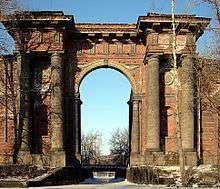Jean-Baptiste Vallin de la Mothe
Jean-Baptiste Michel Vallin de la Mothe (1729 – May 7, 1800) was a French architect whose major career was spent in St. Petersburg, where he became court architect to Catherine II.
He was born in Angoulême, a cousin of the architect-teacher Jacques-François Blondel, under whom he is supposed to have studied,[1] Beginning in 1750, Vallin de la Mothe spent two years studying at the French Academy in Rome, though not as an official pensionnaire. On his return to Paris he was one of the architects who presented projects for Place Lous XV (now Place de la Concorde. In 1759, Vallin de la Mothe accepted an offer extended through the Russian ambassador Aleksei Petrovich Bestuzhev-Ryumin, prompted by Blondel,[2] to teach architecture in St. Petersburg. In St. Petersburg, Vallin de la Mothe adjusted Blondel's designs for a pet project of Shuvalov, the Imperial Academy of Arts (1765–72),[3] in the form of a large open square with a circular central court. As a professor at the Academy, Vallin de la Mothe taught many Russian architects who would themselves be prominent one day including Ivan Starov and Vasili Bazhenov; under the impetus of Vallin de la Mothe, the promising young Russians were sent to Paris to apprentice with Charles De Wailly,[4] thus setting a distinctively French stamp on Russian neoclassicism.
Catherine the Great had been so impressed by his work at the Academy[5] that she commissioned him to build an extension to her Winter Palace, which sits across the Neva River from the Academy. This would be Vallin de la Mothe's most famous work. The structure he built, known as the Small Hermitage, became the home to Catherine's art collection. This collection would eventually grow to be one of the world's largest— today Russia's Hermitage Museum holds over 3,000,000 pieces of art, and hundreds of thousands of tourists visit Vallin de la Mothe's Small Hermitage, along with the rest of the complex, every year.
From 1761 to 1767, he pursued a number of other projects. He designed St. Petersburg's market hall, Gostiny Dvor on Nevsky Prospekt (the main street of St. Petersburg), the palaces of Kirill Razumovsky, Ivan Chernyshyov, the House of Yusupov's Moika Palace (where Grigori Rasputin was murdered[6]), and the New Holland Arch. In 1766 he officially became the court architect.
He began, but did not complete, work on the Catholic Church of St. Catherine. Work on the church was completed by Antonio Rinaldi. In 1775, he returned to his hometown of Angoulême, where he lived for the remainder of his life. The neoclassical hôtel particulier he designed in the 1780s for Louis Thomas de Bardines survives at 79 rue de Beaulieu.[7]
 Arch of New Holland Island, Saint-Petersburg
Arch of New Holland Island, Saint-Petersburg.jpg) Catholic Church of St. Catherine, Saint-Petersburg
Catholic Church of St. Catherine, Saint-Petersburg- Hôtel de Bardines, Angoulême
.jpg) Imperial Academy of Arts, Saint-Petersburg
Imperial Academy of Arts, Saint-Petersburg
Notes
- ↑ David Watkin, A History of Western Architecture 2005:421.
- ↑ Saint Petersburg Encyclopedia.
- ↑ In this project he had the assistance of Russian architects A. F. Kokorinov and Y. M. Felten. (St Petersburg Encyclopedia).
- ↑ Watkin 2005, eo. loc..
- ↑ George Heard Hamilton, The Art and Architecture of Russia 1983:292.
- ↑ "Yusupov Palace". The New York Times. Retrieved on June 10, 2008.
- ↑ Hôtel de Bardines.
External links
-
 Media related to Jean-Baptiste Vallin de La Mothe at Wikimedia Commons
Media related to Jean-Baptiste Vallin de La Mothe at Wikimedia Commons - Vallin de la Mothe J.-B.M. (1729-1800), architect. at St. Petersburg Encyclopedia, ROSSPEN Publishing House
